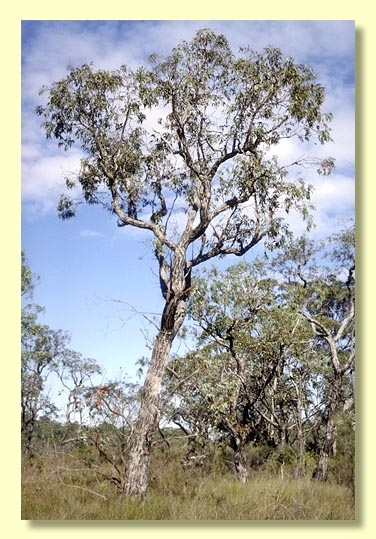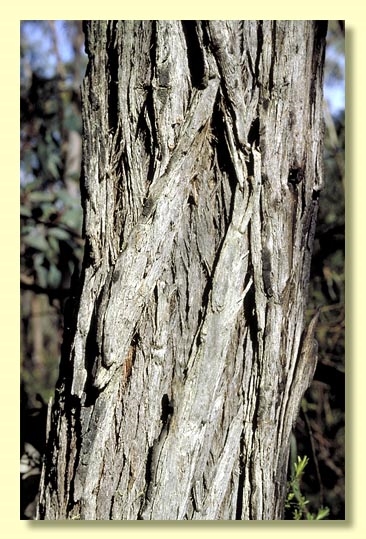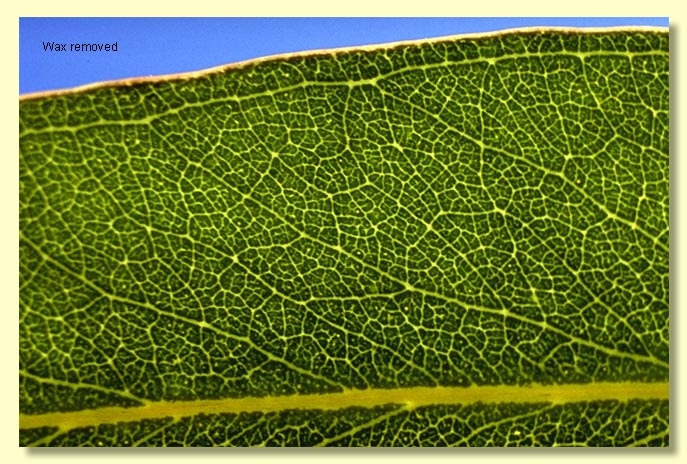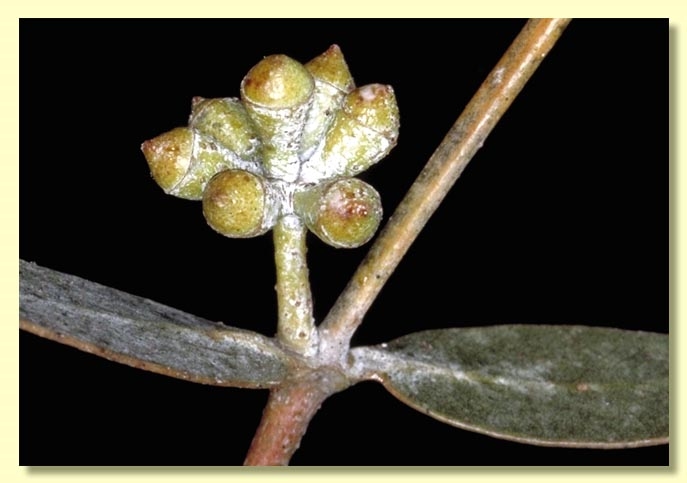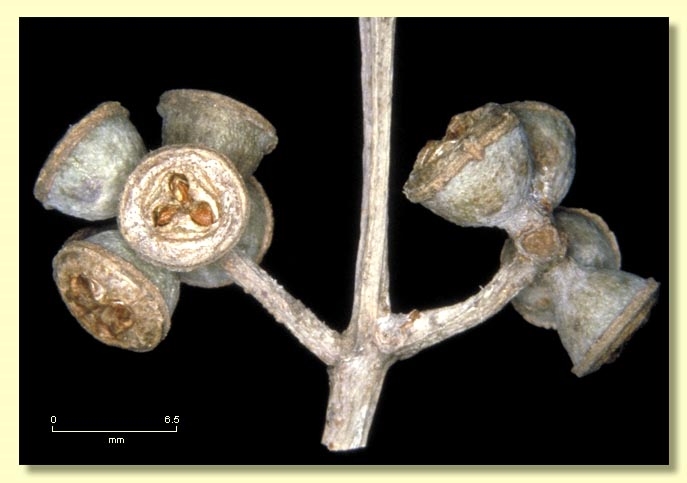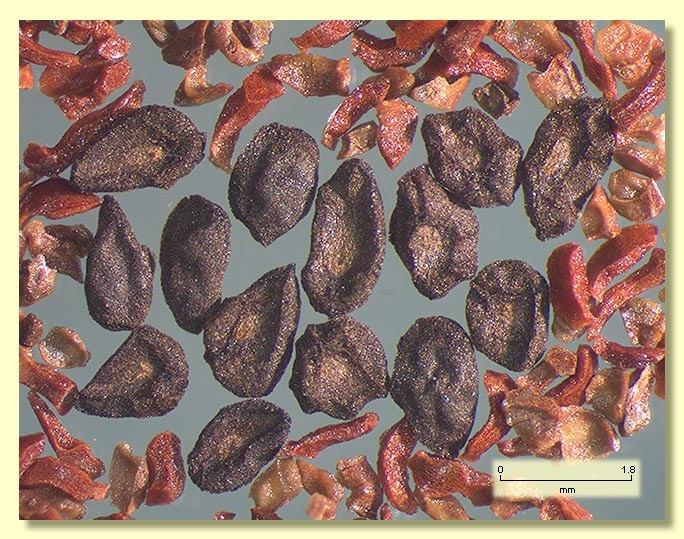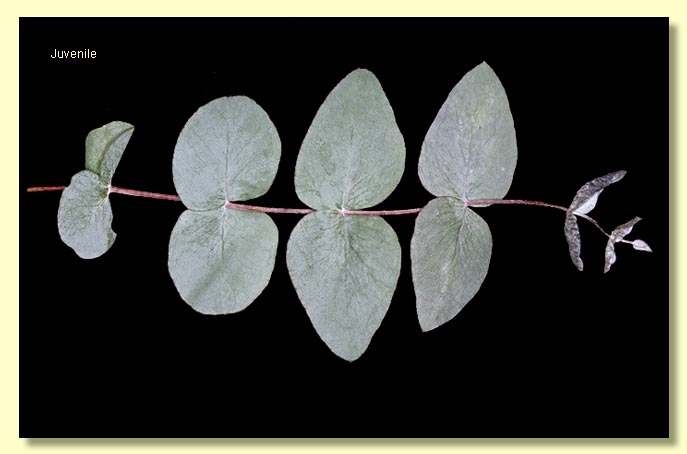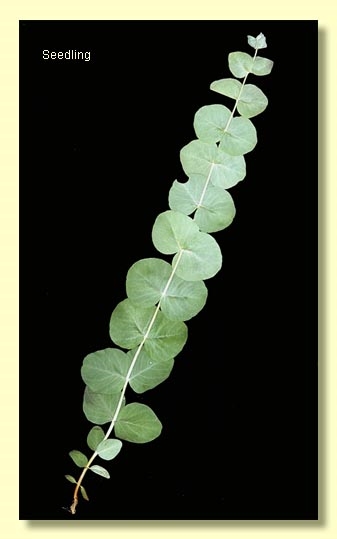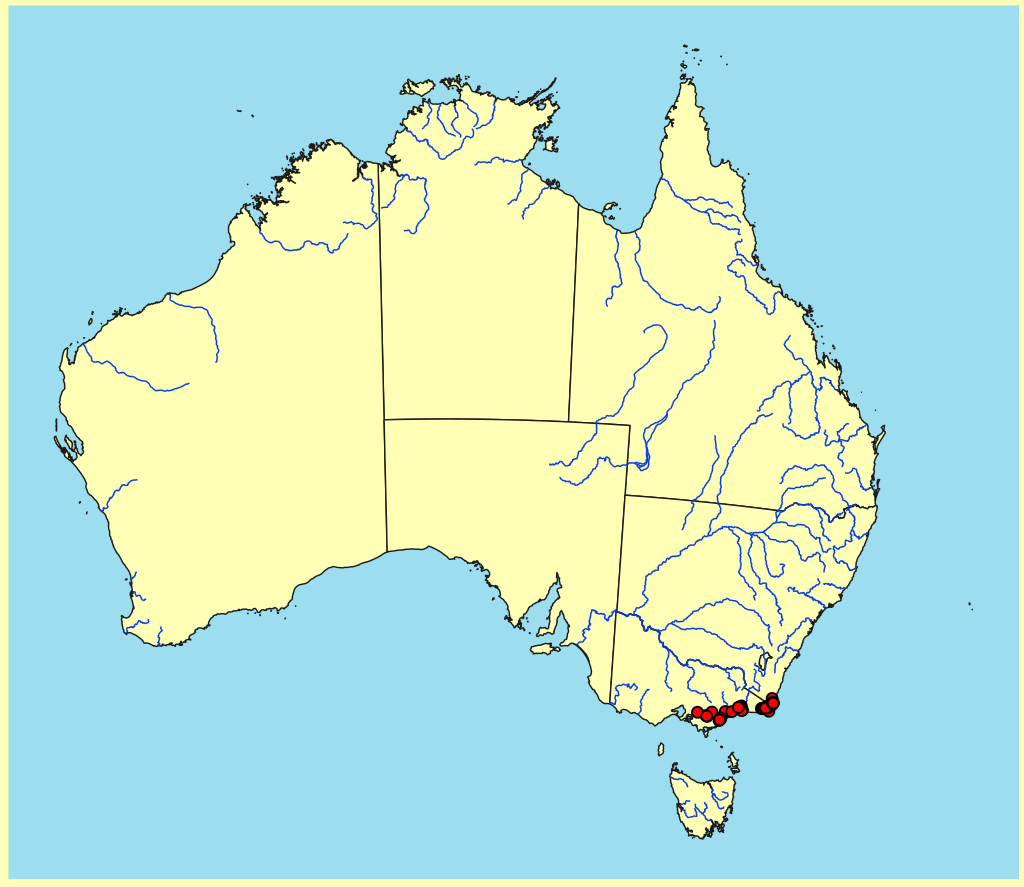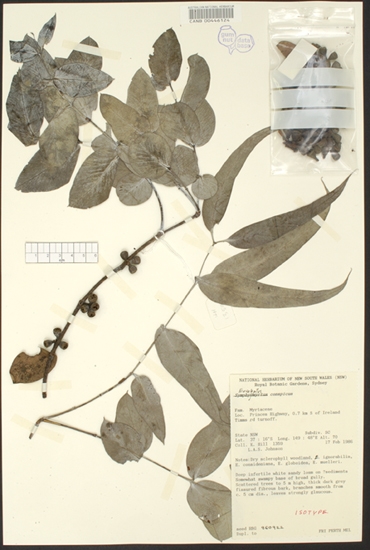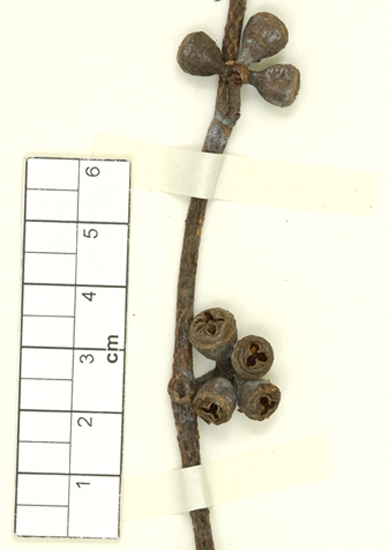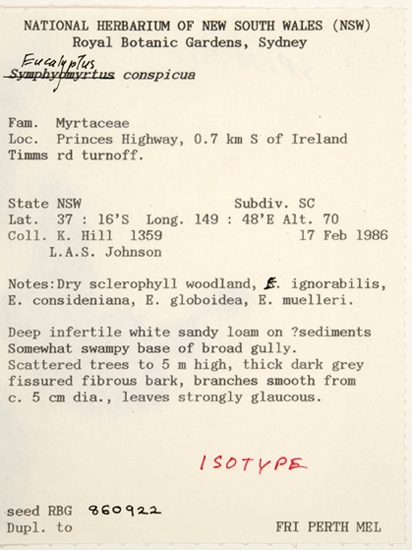Euclid - Online edition
Eucalyptus conspicua subsp. conspicua
Eucalyptus | Symphyomyrtus | Maidenaria | Euryotae | Argyrophyllae
T: NSW, South Coast, 0.7 km S of Ireland Timms Road on Princes Hwy (37 16S 149 48E), 17 Feb. 1986, K.D.Hill 1359 & L.A.S.Johnson; holo: NSW; iso: CANB, MEL, PERTH.
Bark rough to small branches, thick, fibrous, longitudinally furrowed, grey over red-brown; branchlets often glaucous.
Juvenile growth (coppice or field seedlings to 50 cm): stem rounded or square in cross-section, usually glaucous, smooth or warty; juvenile leaves opposite, sessile for many pairs, orbicular to ovate to cordate, 2.5–6 cm long, 2.5–6 cm wide, margin entire or crenulate, blue-green or glaucous, rarely green.
Crown usually blue-green and composed of juvenile, intermediate and adult leaves. Crown leaves opposite or alternate, petiole 0–2.3 cm long; blade lanceolate to falcate to ovate, 6–22 cm long, 1.4–4.5 cm wide, base tapering to petiole or rounded, concolorous, dull, blue-green or glaucous, rarely green.
True alternate petiolate lanceolate to falcate adult leaves form much of the crown; with side-veins usually greater than 45° to midrib, sometimes acute, densely reticulate, intramarginal vein parallel to and well removed from margin, oil glands island or obscure.
Inflorescence axillary unbranched, peduncles 0.5–1.4 cm long, buds 7 per umbel, (uncommonly 3-budded, or with 3s and 7s), sessile or pedicellate (pedicels 0–0.2 cm long). Mature buds fusiform to diamond-shaped, 0.7–1 cm long, 0.4–0.6 cm wide, glaucous or green to yellow, scar present, operculum usually conical, stamens inflexed, anthers cuboid or cuneate, versatile, dorsifixed, dehiscing by longitudinal slits (non-confluent), style long, stigma blunt, locules 3 or 4, the placentae each with 4 vertical ovule rows. Flowers white.
Fruit sessile or on pedicels to only 0.1 cm long, cup-shaped, obconical or hemispherical, 0.4–0.9 cm long, 0.5–0.9 cm wide, glaucous or non-glaucous, disc raised-convex or annular, or disc level, valves 3 or 4, exserted or near rim level.
Seeds black, brown or grey, 1–1.5 mm long, ovoid or flattened-ovoid, often pointed at one end, lacunose, dorsal surface smooth or shallowly pitted, hilum ventral.
Cultivated seedlings (measured at ca node 10): cotyledons bilobed; stems rounded in cross-section, glaucous; leaves sessile and opposite for many nodes, orbicular to cordate, 1.4–3.5 cm long, 2.1–5.5 cm wide, amplexicaul or the base rounded to truncate, margin entire or subcrenulate, apex rounded or emarginate, glaucous to blue-green.
Flowering has been reecorded in January, February and October.
A small tree of restricted distribution in far eastern Victoria south of the Great Dividing Range, east from the Latrobe Valley to Genoa, just extending into south-eastern New South Wales as far as Timbillica and East Boyd State Forest; on slopes and ridges but also on poorly drained soils around intermittent fresh-water swamps (habitat depending on the subspecies). It has rough fibrous bark and the crown consists of opposite sessile juvenile to intermediate leaves and alternate petiolate adult leaves. Umbels have 3 or 7 buds and may form in the axils of opposite or alternate leaves.
Eucalyptus conspicua belongs in Eucalyptus subgenus Symphyomyrtus section Maidenaria, a large group of species more or less restricted to south-eastern Australia, characterised by bilobed cotyledons, simple axillary inflorescences, buds with two opercula (the outer shed during development), stamens with versatile anthers and flattened seeds with a ventral hilum. Within this section, E. conspicua belongs in series Argyrophyllae having longitudinally furrowed fibrous rough bark throughout, orbicular or ovate juvenile leaves opposite for many nodes and small diamond-shaped buds in threes and sevens. There are five species in series Argyrophyllae: E. alligatrix (with 3 subspecies), E. cephalocarpa, E. cinerea (with 2 subspecies), E. conspicua (with 2 subspecies), E. nova-anglica.
Eucalyptus conspicua is related to E. cinerea from which it differs in the crown of coarse juvenile/intermediate and adult leaves and umbels of both 3s and 7s (buds in 3s in E. cinerea). Coppice growth typical of series Argyrophyllae is usually seen at the sites of occurrence, i.e. opposite, orbicular glaucous leaves on regrowth and saplings to 1.5 m tall. In eastern Victoria the range of E. conspicua overlaps with that of the closely related and seven-budded E. cephalocarpa. Both species have similar rough bark however on plants of E. cephalocarpa in the Genoa to Mallacoota area the rough bark may only develop on the lower trunk. Both species have similar juvenile or coppice growth. The buds of E. conspicua are larger than those of E. cephalocarpa, whilst its crown leaves are frequently opposite, coarser-textured and usually glaucous, compared with the alternate, thinner-textured, narrower, green leaves of E. cephalocarpa. E. cephalocarpa often has glaucous new adult leaf growth in the crown in spring-summer but the leaves usually quickly mature to green. Confusingly in far East Gippsland both species grow near intermittent swamps dominated by the sedge Ghania with E. conspicua always lower in the landscape than is E. cephalocarpa.
In 2018 Rule and Walsh described a new subspecies, Eucalyptus conspicua subsp. dispar.
E. conspicua subsp. conspicua
Occurs around lowlying areas from the Latrobe Valley in Victoria east to Timbillica and Sidling Swamp in New South Wales. A well-developed spreading tree further characterized by its stronger development towards a crown of petiolate alternate lanceolate-falcate adult leaves although with some opposite sessile and petiolate ovate leaves always present as well. Umbels have 7 shortly pedicellate buds.
E. conspicua subsp. dispar
Endemic to Victoria where sporadically distributed from Seaton near Heyfield east to the country north of Bruthen towards Buchan, on hills and ridges with impoverished soils derived from sedimentary rock. It differs from typical subsp. conspicua in having buds 3(7) per umbel, crown mostly of juvenile and intermediate leaves and spindly growth habit on fooothill sites rather than the lowland sites favoured by the more robust 7-budded trees of subsp. conspicua. E. conspicua subsp. dispar is sometimes mistaken for E. cinerea but differs in the much coarser crown leaves and variable buds numbers. In Victoria E. cinerea only occurs around Beechworth.
E. conspicua is sometimes an associate of the distantly related E. ignorabilis, which has finely fibrous rough-bark, but has non-glaucous oblong-lanceolate juvenile leaves opposite for only a few nodes and a crown of green to grey-green adult leaves.
Eucalyptus conspicua: Latin conspicuus, conspicuous, referring to the contrasting, overall glaucous colour of the crown.
subsp. dispar: Latin dispar meaning different, refererring to the habit and habitat and crown differences between this and the typical form.

